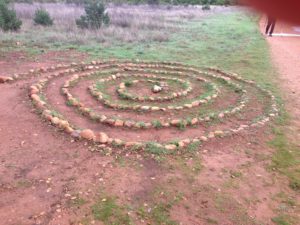‘Life isn’t a straight line.’
On Being.
How to chart your own ‘River of Life.’
Before one of his poetry readings at the On Being Gathering, David Whyte quoted these famous lines from poet Antonio Machado:
“Caminante, no hay camino,
se hace camino al andar.
Al andar se hace camino …”
“Pathmaker, there is no path,
You make the path by walking.
By walking, you make the path …”
River of Life Exercise
Editor’s Note: This activity was originally developed by Joyce Mercer. It is edited and adapted with permission.
All you need is a pen and a blank sheet of paper. Give yourself at least 30 minutes to work through it.
Step One: Reflect
Think about the course of your life. Take a moment to consider the following questions:
- If your life were a river, what shape would it take?
- Where are the bends and turns, when your situation or perspective changed? Was the transition smooth or sudden?
- Are there rocks or boulders — obstacles or life-altering moments — falling into your river?
- Are there points at which it flows powerfully and purposefully or slows to a trickle?
Step Two: Frame
Draw your river of life with its bends and turns, smooth waters and rough spots, strength and vitality.
- Label your approximate age and/or dates along the flow of your river.
- Identify various key events in your life that shape your story — the boulders in the river or places where the river changes course.
- If you were to divide your life journey into sections, where would the sections divisions occur? Name each of the sections of your life river.
Step Three: Guide
Think about the various people who have accompanied you along this river’s journey. Record these key relationships and losses in the appropriate places on your river of life. If you wish, you can also record thoughts and feelings attached to these relationships.
- What relationships have been most significant at different positions in your life?
- Who has most shaped you?
- Have there been significant losses of relationships along the way?
- What groups or communities of people were most important?
Step Four: Contextualize
Reflect on your life’s journey and trajectory. Using words and/or symbols, place life events in the appropriate locations on your diagram.
- Are there times of significant pain or suffering — yours or others’ — that shape the flow of your life river?
- What was going on in the world — locally, regionally, or around the world — that shape the flow of your life river?
Step Five: Evaluate
Note what has been important to you.
- What values, commitments, causes, or principles were most important to you at a given point in your life?
- Toward what goals, if any, were your primary energies directed? Or, metaphorically speaking, what purposes and ends helped to shape the flow of life waters at a given time in your experience?
As you finish depicting your river of life, review the whole diagram. Do its symbols and words seem to portray how you think and feel about the whole of your life? Is there some important element left out? Make adjustments as needed. Remember that no diagram can possibly capture all that shapes your journey.
You can share your river of life with others or simply use it as a tool for personal reflection.
PDF printable version:
https://onbeing.org/wp-content/uploads/2019/05/on-being-river-of-life-exercise.pdf

Leave a Reply